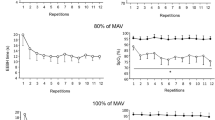Abstract
The study was carried out on ten triathletes, six sprinters and ten subjects not trained in running (controls) to assess the effects of training history on the co-ordination between breathing and running rhythms during running on a treadmill. Three exercise intensities were used: 50%, 80% and 110% of the subject's anaerobic threshold (AT). All three intensities were performed twice: once with spontaneous breathing and once with breathing intentionally co-ordinated to the running rhythm. Heart rate, respiratory parameters and leg movements were continuously recorded. Blood lactate concentrations were measured discontinuously. The degree of co-ordination between running and breathing was quantified as the percentage of inspirations and/or expirations starting during the same phase of step. The results showed that the degree of both spontaneous and intended co-ordination at aerobic exercise intensities was in all three groups the same and increased in all groups with increasing intensity from 50% to 80% of AT; further increase of intensity to 110% of AT was associated with a significant decrease of co-ordination in controls and sprinters, whereas triathletes were able to maintain the same high degree of co-ordination as at 80% of AT. It was concluded that running training of either type at aerobic work loads had no effect on the co-ordination between running and breathing rhythms. At anaerobic intensities, however, the degree of co-ordination between running and breathing rhythms was higher in the endurance trained athletes than in the sprinters or in the untrained subjects. The degree of co-ordination increased with increasing regularity of breathing. The ability to increase intentionally the degree of co-ordination by paced breathing was independent of running training and was lowest at anaerobic exercise intensities.
Similar content being viewed by others
References
Agostoni E, D'Angelo E (1976) The effect of limb movements on the regulation of depth and rate of breathing. Respir Physiol 27:33–52
Asmussen E (1973) Ventilation at transition from rest to exercise. Acta Physiol Scand 89:68–78
Auerbach K, Israel S (1990) Die Atmung bei Ausdauerlauf. Sportpädagogik 14:12–13
Banzett RB, Mead J, Reid MB, Topulos GP (1992) Locomotion in men has no appreciable mechanical effect on breathing. J Appl Physiol 72:1922–1926
Bechbache RR, Duffin J (1977) The entrainment of breathing frequency by exercise rhythm. J Physiol (Lond) 272:553–561
Bernasconi P, Kohl J (1993) Analysis of co-ordination between breathing and exercise rhythms in man. J Physiol (Lond) 471:693–706
Boutellier U, Kündig T, Gomez U, Pietsch P, Koller EA (1987) Respiratory phase detection and delay determination for breathby-breath analysis. J Appl Physiol 62:837–843
Bramble DM, Carrier DR (1983) Running and breathing in mammals. Science 219:251–256
Buess C, Pietsch P, Guggenbühl W, Koller EA (1986) Design and construction of an ultrasonic air-flowmeter. IEEE Trans Biomech Eng 33:768–774
Bührer A, Gähwiler M, Schuster K, Koller EA (1993) Expandable modular measurement system for respiration analysis and human subject monitoring in a low pressure chamber. Experientia 49:A61
Comroe JH Jr, Schmidt CF (1942-43) Reflexes from the limbs as a factor in the hyperpnea of muscular exercise. Am J Physiol 138:536–547
Conconi F, Ferrari M, Zigho PG, Droghetti P, Codeca I (1982) Determination of the anaerobic threshold by a noninvasive field test in runners. J Appl Physiol 52:869–873
Eldridge FL, Millhorn DE, Waldrop TG (1981) Exercise hyperpnea and locomotion: parallel activation from the hypothalamus. Science 211:844–846
Flandrois F, Lacour JR, Islas Marquin J, Charlot J (1966) Essai de mise en Evidence d'un stimulus neurogénique articulaire de la ventilation lors de l'exercice musculaire chez le chien. J Physiol (Paris) 58:222–223
Garlando F, Kohl J, Koller EA, Pietsch P (1985Effect of coupling the breathing-and cycling rhythms on oxygen uptake during bicycle ergometry. Eur J Appl Physiol 5:497–501
Gautier H, Lacaisse A, Pasquis P, Dejours P (1964) Reactions ventilatoires a la stimulation des fuseaux neuro-musculaires par la succinylcholine chez le chat. J Phisiol (Paris) 56:560–561
Jasinskas CL, Wilson BA, Hoare J (1980) Entrainment of breathing rate to movement frequency during work at two intensities. Respir Physiol 42:199–209
Kawahara K, Kumagai S, Nakazono Y, Miyamoto Y (1989) Coupling between respiratory and stepping rhythms during locomotion in decerebrate cats. J Appl Physiol 67:110–115
Kohl J, Koller EA, Jäger, M (1981) Relation between pedaling and breathing rhythm. Eur J Appl Physiol 47:223–237
Krogh A, Lindbard J (1913) The regulation of respiration and circulation during the initial stages of muscular work. J Physiol (Lond) 47:112–136
Mahler DA, Hunter B, Lentine T, Ward J (1991a) Locomotorrespiratory coupling develops in novice female rowers with training. Med Sci Sport Exerc 23:1362–1366
Mahler DA, Shuhart C, Brew E, Stukel TA (1991b) Ventilatory responses and entrainment of breathing during rowing. Med Sci Sport Exerc 23:186–192
Paterson DJ, Wood GA, Morton AR, Henstridge JD (1986) The entrainment of ventilation frequency to exercise rhythm. Eur J Appl Physiol 55:530–537
Paterson DJ, Wood GA, Marshall RN, Morton AR, Harrison ABC (1987) Entrainment of respiratory frequency to exercise rhythm during hypoxia. J Appl Physiol 62:1767–1771
Sachs L (1978) Angewandte Statistik. 5th edn. Springer, Berlin Heidelberg New York
Takano N (1993) Ventilatory responses during arm and leg exercise at varying speeds and forces in untrained female humans. J Physiol (Lond) 468:413–424
Author information
Authors and Affiliations
Rights and permissions
About this article
Cite this article
Bernasconi, P., Bürki, P., Bührer, A. et al. Running training and co-ordination between breathing and running rhythms during aerobic and anaerobic conditions in humans. Europ. J. Appl. Physiol. 70, 387–393 (1995). https://doi.org/10.1007/BF00618488
Accepted:
Issue Date:
DOI: https://doi.org/10.1007/BF00618488




